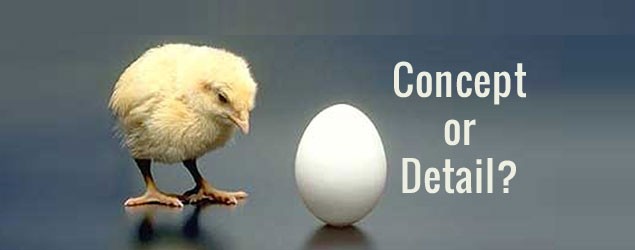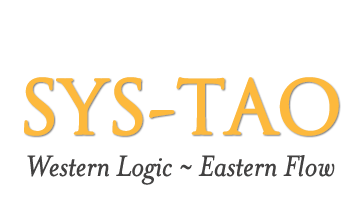
Which came first: The concept or the details? It is easier for us to understand new things when we already have a concept before we are supplied with details. The details then allow us to better understand or improve our concept. It is as if the details somehow attach themselves to something we already think we know in order for us to make better sense of both the concept and the details.
An example might be that we are more comfortable accepting a new product when its benefits are presented to us before its features. Consider the universal TV remote control. No one would be interested in all those buttons without some hope of a benefit. (Personally, I have given up hope on this one.)
Intuitively, “concept before detail” makes perfect sense. But it presupposes that we already have a concept in the first place. What if we don’t already have a concept to build upon? Most likely, we’d just fabricate a concept. We’d have to make up a story to make sense of what’s happening; otherwise, we’d just dismiss the details as extraneous noise. Maybe that’s where mythology comes from – we just make up reasons in order to make sense of the details that surround us… and end up with theories that we think explain our world. So, in this way the details do come first, but for most of us there is already some concept out there that we can use and build upon.
We can remember details for a short time, but not until we attach them to a concept do they play a part in our long-term memory of the things we think we know.
There is, however, a problem with this “concept before detail” idea: What if we already have a concept – even if it is only a myth – and then what if someone comes along with an entirely new concept for the same details? Now we have a hard choice: We can hang on to our old beliefs, level out those details that are troublesome, and sharpen up those details that fit our established beliefs – or we can let go of what we thought we knew to be true and accept the new theory. This dilemma describes a paradox:
Paradox defined: Paradox is used in a particular way within the literature of economics to describe situations in which apparent facts are in conflict with models or theories (paradigms) to which some class of people hold allegiance. This use of the word, paradox, implies a strong belief in both the measured facts, and in the paradigm. The resolution to economic paradoxes tends to be of the form that the data does not fit the paradigm, or the data is not correct or, (the most common case) the paradigm does not fit the environment measured. Wikipedia
Our older concepts (paradigms) are based on lots of experience with lots of details and they are rooted in our habits. The networks of neurons in our neo-cortex have wired together over time and created our existing paradigms. Likewise, our limbic system has created habits to reinforce these beliefs. It is very difficult to just give up old concepts and change old habits even when they do not fit the facts. We are blinded by our beliefs and trapped inside our own biological system of concepts and habits.
It is easier to just re-interpret new concepts and details in order to make them fit into our existing paradigms. Biologically, we are not adept at willfully rewiring our own biological system.
“Great is the power of steady misrepresentation” ― Charles Darwin
Maybe this is part of the reason that traditional leadership philosophies are so slow to change, and why cultures so predictably lag behind changes in technology. But, with the ever-increasing pace of change, this presents an obvious problem. Darwin first put his finger on this concept – life evolves in order to fit the changing environment, or it becomes extinct.
“In the long history of humankind (and animal kind, too) those who learned to collaborate and improvise most effectively have prevailed.” ― Charles Darwin
The organizations we inhabit must encourage the acceptance of new concepts and new ways of behavior, or they too must face the consequences and become extinct.
It is the environment that allows life to continually evolve, thrive, sustain itself, and become better. Command and Control Structures protect the established ways and inhibit new ways of thinking and acting. A Process Control Environment is more lifelike, and it nurtures this kind of change. “Which came first – the concept or the detail?” – is the wrong question. The right question is:
“How best to maintain and sustain an environment that will nurture the emerging complexity of life, and the continual improvement of our paradigms and our habits?”― Bob Browne
Sys-Tao recounts how the associates of Great Plains Coca-Cola Bottling Company experienced the answer to this question. In the following 30-minute video, John Seddon recounts the seminal moments of how he discovered these same truths and developed what he calls The Vanguard Method.
As Seddon considered the details of how “work” works – the process – his paradigm shifted away from a Command and Control point of view and towards a systems point of view. When he studied the details of work in this way, improved concepts emerged naturally. The organizational environment changed. Only when the organizational environment changes do the people change too.
Changing your mind is hard.
Changing your habits is harder.
Changing an organization’s culture is even more difficult

